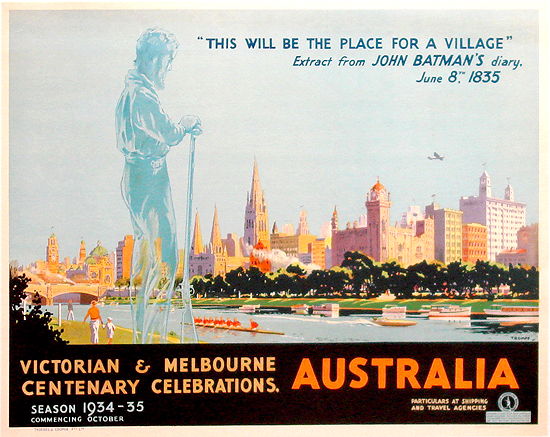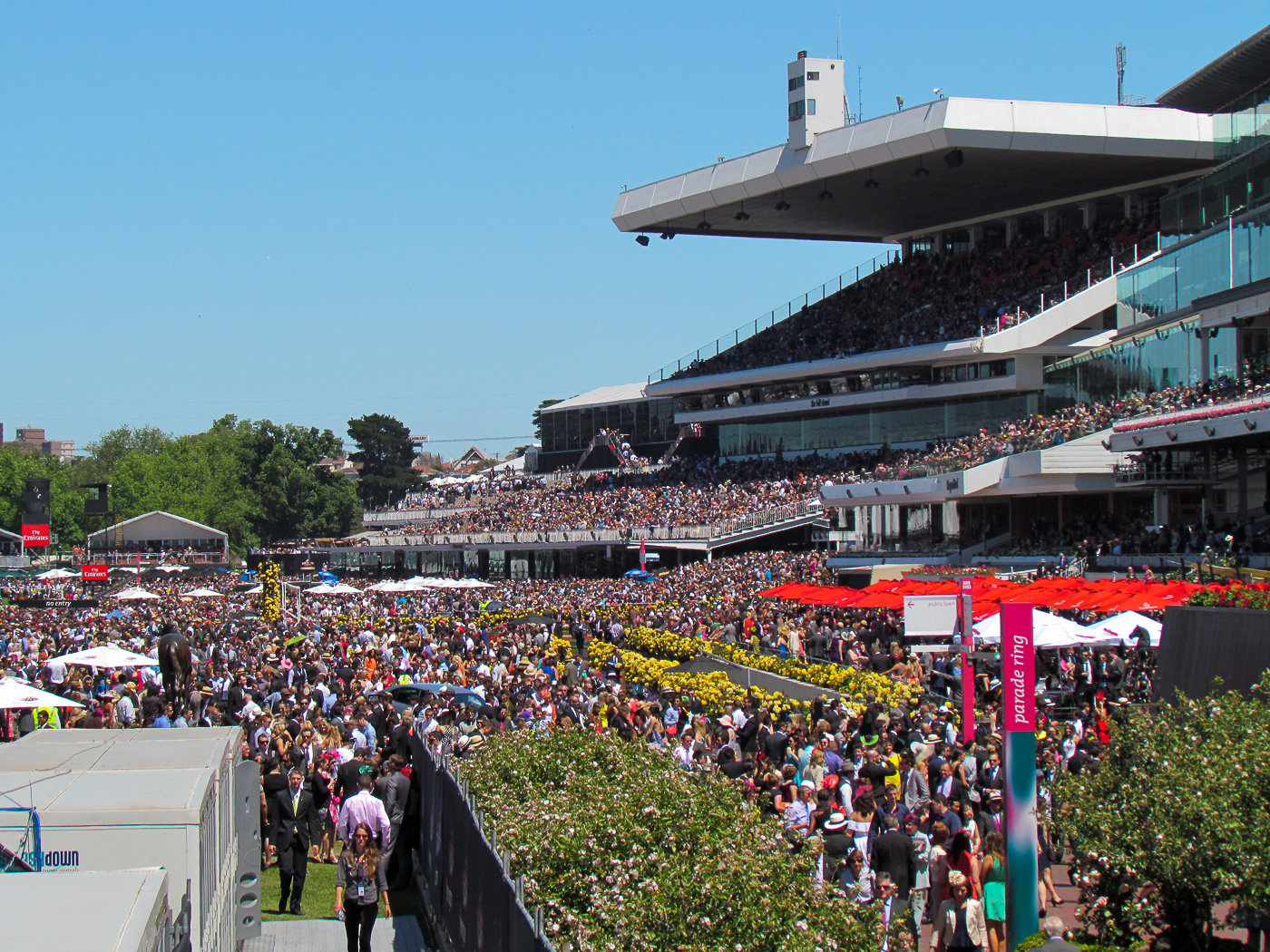|
Melbourne Centenary
The Melbourne Centenary was a 1934 centennial celebration of the founding of the city of Melbourne, Australia. As Victoria reeled from the severe economic and social fracturing of the Great Depression, its Centenary celebrated progress and community cohesion. Held between October 1934 and June 1935, the Centenary in fact celebrated two 'foundation' events, firstly commemorating Edward Henty's Portland settlement on 19 November 1834 as the first white settlement in what would later become the state of Victoria, then John Batman's pronouncement of the area upstream of the Yarra River as 'the place for a village', taken as the city's foundation, on 8 June 1835. John Batman was promoted as an heroic icon in an effort to embody the rewarding aspects of self-improvement, and was given more prominence as a founding father rather than John Pascoe Fawkner, whose advance party had in fact settled the site of the city where the Customs House is now located before Batman's party could ret ... [...More Info...] [...Related Items...] OR: [Wikipedia] [Google] [Baidu] |
Harold Gengoult Smith
Sir Harold Gengoult Smith (25 July 1890 – 14 April 1983) was an Australian medical practitioner who served as Lord Mayor of Melbourne from 1931 to 1934. Smith was born in Melbourne to Marion Jane (née Higgins) and Louis Lawrence Smith, both English immigrants. His father was a doctor and member of parliament, while his sister was the musical publisher Louise Hanson-Dyer. Smith attended Melbourne Grammar School and then moved to Scotland to study medicine. However, his studies were interrupted by the war and he instead enlisted in the British Army, serving in France with the 2nd Dragoon Guards. Smith eventually received his qualifications in medicine in 1917. He subsequently returned to Australia and began practising at his father's chambers on Collins Street.John Young, 'Smith, Sir Harold Gengoult (1890–1983)', Australian Dictionary of Biography, National Centre of Biography, Australian National University, http://adb.anu.edu.au/biography/smith-sir-harold-gengoult-15901/te ... [...More Info...] [...Related Items...] OR: [Wikipedia] [Google] [Baidu] |
Cooks' Cottage
Cooks' Cottage, previously known as Captain Cook's Cottage, is located in the Fitzroy Gardens, Melbourne, Australia. The cottage was constructed in 1755 in the English village of Great Ayton, North Yorkshire, by the parents of Captain James Cook, James and Grace Cook, and was brought to Melbourne in 1934 by Sir Russell Grimwade. It is a point of conjecture among historians whether James Cook, the famous navigator, ever lived in the house, but almost certainly he visited his parents at the house. The inside of the cottage includes centuries-old antiques and is stylised in the way of the 18th century, as are the clothes of the volunteer guides. History In 1933 the owner of the cottage decided to sell it with a condition of sale that the building remain in England. She was persuaded to change "England" to "the Empire", and accepted an Australian bid of £800, by Russell Grimwade, as opposed to the highest local offer of £300. The cottage was deconstructed brick by brick and pack ... [...More Info...] [...Related Items...] OR: [Wikipedia] [Google] [Baidu] |
Royal Botanic Gardens, Melbourne
Royal Botanic Gardens Victoria are botanic gardens across two sites–Melbourne and Cranbourne. Melbourne Gardens was founded in 1846 when land was reserved on the south side of the Yarra River for a new botanic garden. It extends across that slope to the river with trees, garden beds, lakes and lawns. It displays almost 50,000 individual plants representing 8,500 different species. These are displayed in 30 living plant collections. Cranbourne Gardens was established in 1970 when land was acquired by the Gardens on Melbourne's south-eastern urban fringe for the purpose of establishing a garden dedicated to Australian plants. A generally wild site that is significant for biodiversity conservation, it opened to the public in 1989. On the site, visitors can explore native bushland, heathlands, wetlands and woodlands. One of the features of Cranbourne is the Australian Garden, which celebrates Australian landscapes and flora through the display of approximately 170,000 plan ... [...More Info...] [...Related Items...] OR: [Wikipedia] [Google] [Baidu] |
National Herbarium Of Victoria
The National Herbarium of Victoria ( Index Herbariorum code: MEL) is one of Australia's earliest herbaria and the oldest scientific institution in Victoria. Its 1.5 million specimens of preserved plants, fungi and algae—collectively known as the State Botanical Collection of VictoriaRoyal Botanic Gardens VictoriaState Botanical Collection at the National Herbarium(accessed 20 August 2020)—comprise the largest herbarium collection in Australia and Oceania.Thiers, B. (2020 - continuously updated). National Herbarium of Victoria Collections Summary. ''Index Herbariorum. A global directory of public herbaria and associated staff. New York Botanical Garden’s Virtual Herbarium.'' Available fromMEL Collections Summary(accessed 21 August 2020) The collection includes scientifically and historically significant collections gathered by Joseph Banks and Daniel Solander during the voyage of in 1770, as well as 2,000 specimens collected by Robert Brown during Flinders' circumnav ... [...More Info...] [...Related Items...] OR: [Wikipedia] [Google] [Baidu] |
Shrine Of Remembrance
The Shrine of Remembrance (commonly referred to as The Shrine) is a war memorial in Melbourne, Victoria, Australia, located in Kings Domain on St Kilda Road. It was built to honour the men and women of Victoria who served in World War I, but now functions as a memorial to all Australians who have served in any war. It is a site of annual observances for Anzac Day (25 April) and Remembrance Day (11 November), and is one of the largest war memorials in Australia. Designed by architects Phillip Hudson and James Wardrop, both World War I veterans, the Shrine is in classical style, based on the Tomb of Mausolus at Halicarnassus and the Parthenon in Athens, Greece. The crowning element at the top of the ziggurat roof references the Choragic Monument of Lysicrates. Built from Tynong granite, the Shrine originally consisted only of the central sanctuary surrounded by the ambulatory. The sanctuary contains the marble Stone of Remembrance, upon which is engraved the words "Greater ... [...More Info...] [...Related Items...] OR: [Wikipedia] [Google] [Baidu] |
Yarra River
The Yarra River or historically, the Yarra Yarra River, (Kulin languages: ''Berrern'', ''Birr-arrung'', ''Bay-ray-rung'', ''Birarang'', ''Birrarung'', and ''Wongete'') is a perennial river in south-central Victoria, Australia. The lower stretches of the Yarra are where Victoria's state capital Melbourne was established in 1835, and today metropolitan Greater Melbourne dominates and influences the landscape of its lower reaches. From its source in the Yarra Ranges, it flows west through the Yarra Valley which opens out into plains as it winds its way through Greater Melbourne before emptying into Hobsons Bay in northernmost Port Phillip Bay. The river has been a major food source and meeting place for Indigenous Australians for thousands of years. Shortly after the arrival of European settlers, land clearing forced the remaining Wurundjeri people into neighbouring territories and away from the river. Originally called ''Birrarung'' by the Wurundjeri, the current name was mis ... [...More Info...] [...Related Items...] OR: [Wikipedia] [Google] [Baidu] |
MacRobertson Bridge
The MacRobertson Bridge is a road bridge that carries Grange Road from Toorak on the south bank into Burnley, over the Yarra River and the Monash Freeway in Melbourne, Victoria, Australia. The first river crossing at the site was Twickenham Ferry, which conveyed passengers and was founded by waterman Jesse Barrow in 1880. it was named for the Twickenham Ferry in London. The ferry survived until 1934, when it was replaced by the MacRobertson Bridge, financed by Sir Macpherson Robertson Sir Macpherson Robertson KBE (6 September 185920 August 1945) was an Australian philanthropist, entrepreneur and founder of chocolate and confectionery company '' MacRobertson's''. He was also known for bringing the United States inventions of .... When built the bridge was one of two bridges in the world to be the first to use welded steel trusses. As built the bridge only spanned the Yarra, but in 1967 the South Eastern Arterial was built, running under the northernmost span. Reference ... [...More Info...] [...Related Items...] OR: [Wikipedia] [Google] [Baidu] |
Flemington Racecourse
Flemington Racecourse is a major horse racing venue located in Melbourne, Victoria, Australia. It is most notable for hosting the Melbourne Cup, which is the world's richest handicap and the world's richest 3200-metre horse race. The racecourse is situated on low alluvial flats, next to the Maribyrnong River. The area was first used for horse racing in March 1840. Overview The Flemington Racecourse site comprises 1.27 square kilometres of Crown land. The course was originally leased to the Victoria Turf Club in 1848, which merged with the Victoria Jockey Club in 1864 to form the Victoria Racing Club. The first Melbourne Cup was run in 1861. In 1871 the Victoria Racing Club Act was passed, giving the VRC legal control over Flemington Racecourse. The racecourse is pear-shaped, and boasts a six-furlong (1,200 m) straight known as 'the Straight Six.' The track has a circumference of and a final straight of for race distances over . Races are run in an anti-clockwise ... [...More Info...] [...Related Items...] OR: [Wikipedia] [Google] [Baidu] |
Tom Campbell Black
Tom Campbell Black (December 1899 – 19 September 1936) was an aviator, English aviator. He was the son of Alice Jean McCullough and Hugh Milner Black. He became a world-famous aviator when he and C. W. A. Scott won the London to Melbourne Centenary Air Race in 1934. Early years Tom Campbell Black attended Brighton College and the records for the period summer 1915 to summer 1917 indicate that he entered Hampden House, May 1915, was appointed House Prefect, January 1917 and played Second XI Football, 1915 to 1916 and 1916 to 1917. Campbell Black attended Army Class II and entered the RN College at Greenwich and attained a commission in the R.N.A.S. (Naval Air Service). He served first as a pilot in the Naval Air Service and later in the RAF during the World War I, Great War, rising to the rank of captain. Arriving in Africa as a soldier settler in 1922, he joined his brother, Frank Milner Black, who had been stationed as a soldier in Kenya and decommissioned in 1920. [...More Info...] [...Related Items...] OR: [Wikipedia] [Google] [Baidu] |
Grosvenor House
Grosvenor House was one of the largest townhouses in London, home of the Grosvenor family (better known as the Dukes of Westminster) for more than a century. Their original London residence was on Millbank, but after the family had developed their Mayfair estates, they moved to Park Lane to build a house worthy of their wealth, status and influence in the 19th century. The house gave its name to Upper Grosvenor Street and Grosvenor Square. The house was requisitioned during the First World War, and was sold and demolished in the 1920s. The Grosvenor House Hotel was built on its site. History The site was originally occupied by a small house named 'Gloucester House' (after Prince William Henry, Duke of Gloucester and Edinburgh, who owned it), with the front entrance on Upper Grosvenor Street. This house was purchased by Robert Grosvenor, 1st Marquess of Westminster, in 1805 for £20,000. He spent £17,000 on extending the house to make it more fashionable. In 1821, a lar ... [...More Info...] [...Related Items...] OR: [Wikipedia] [Google] [Baidu] |







